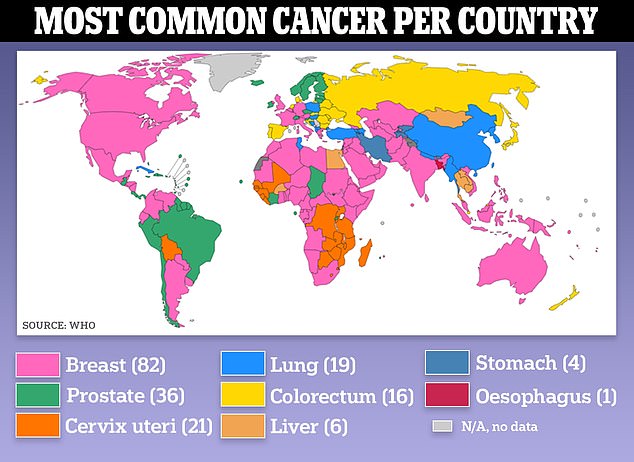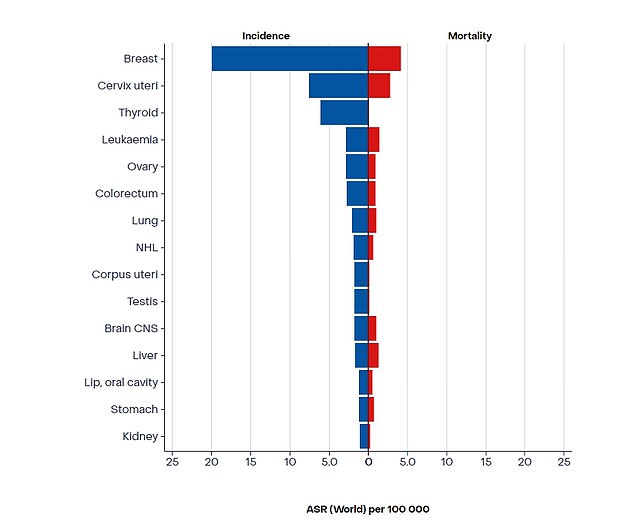Last week, a US medical task force lowered the age at which it is recommended that women get screened for breast cancer: from 50 to 40.
The US Preventive Services Task Force (USPSTF) said that women with an average risk of breast cancer – determined by their doctor based on genetics and lifestyle – should Get a mammogram every two years from age 40 to age 74.
Women at higher risk due to genetics or certain medical history should discuss options with their doctor, which remains unchanged from previous guidelines.
Previously, the medical group said the only women under age 50 who should be routinely screened are those at high genetic risk.
The change responds to the increase in cases of early-onset breast cancer, those diagnosed in women under 50 years of age, which has been linked to poor nutrition, obesity and exposure to toxic substances.
Breast cancer accounts for about 30 percent of all new female cancers per year (file image)
It is not yet clear whether health insurance companies will universally cover the screening test because of the updated guidelines and coverage typically varies from woman to woman and policy to policy.
Out-of-pocket costs for a mammogram can range from $140 to $300.
Emergency physician Dr. Leana Wen said she encourages women to learn about the new guidelines and discuss them with their doctor, noting that the update only applies to women with average cancer risk.
Dr. Wen said CNN: ‘In recent years, there has been a disturbing trend of increasing cancer diagnoses among young people. This is the case with both colon and breast cancer.
“I encourage women to review this updated guidance and discuss it with their doctors.”
A mammogram is an x-ray image of the breast that is used to detect and diagnose breast cancer in women.
It uses low-dose x-rays to obtain an image of the inside of the breasts to look for masses or other abnormalities that may indicate cancer.

The above shows the most common type of cancer in each country, with breast cancer being the main form in dozens of countries.

The above shows the most common cancers and their mortality rates in all countries in the world.
It is a non-invasive test in which women stand in front of an X-ray machine while the plates flatten the breast while the machine takes images. The process will be repeated at multiple angles of both breasts, but usually only takes several minutes.
The USPSTF’s updated guidelines are now more in line with those of other medical bodies.
The American College of Obstetricians and Gynecologists recommends mammograms every one to two years starting at age 40, and the American Cancer Society suggests that women ages 40 to 44 get mammograms every year, but strongly recommends them for women age 45. years or more.
In the US, breast cancer is the second most common cancer after skin cancer, and worldwide it is most common in dozens of countries, including the United Kingdom, Canada, India, South Africa, Australia, and Mexico.
The ACS estimates that there will be about 310,300 new cases in 2024 and 42,250 women will die from the disease.
The average lifetime risk for women of developing breast cancer is 13 percent, meaning one in eight women will develop the disease.
The average age of diagnosis is 62 years and only a small number of women are diagnosed with the disease before the age of 45.
However, rates around that age have been increasing.
The ACS said the increase in incidence rates in women under age 50 is one percent, while the overall incidence rate is 0.6 percent annually.
And the USPSTF said incidence increased gradually among women ages 40 to 49 from 2000 to 2015, but increased most notably from 2015 to 2019, with an average annual increase of 2.0 percent.
The rise in breast cancer among younger women follows a similar global trend that is seeing an increase in early-onset cancer diagnoses – those in people under 50.
And younger women tend to have more aggressive forms of breast cancer compared to women diagnosed at older ages.
The disease is the second cause of cancer death in women, behind lung cancer.
About one in 40 women will die from breast cancer, and that number has been steadily declining since 1989.
Early detection and intervention, as well as increased awareness, are believed to be the causes of the drop in deaths.

